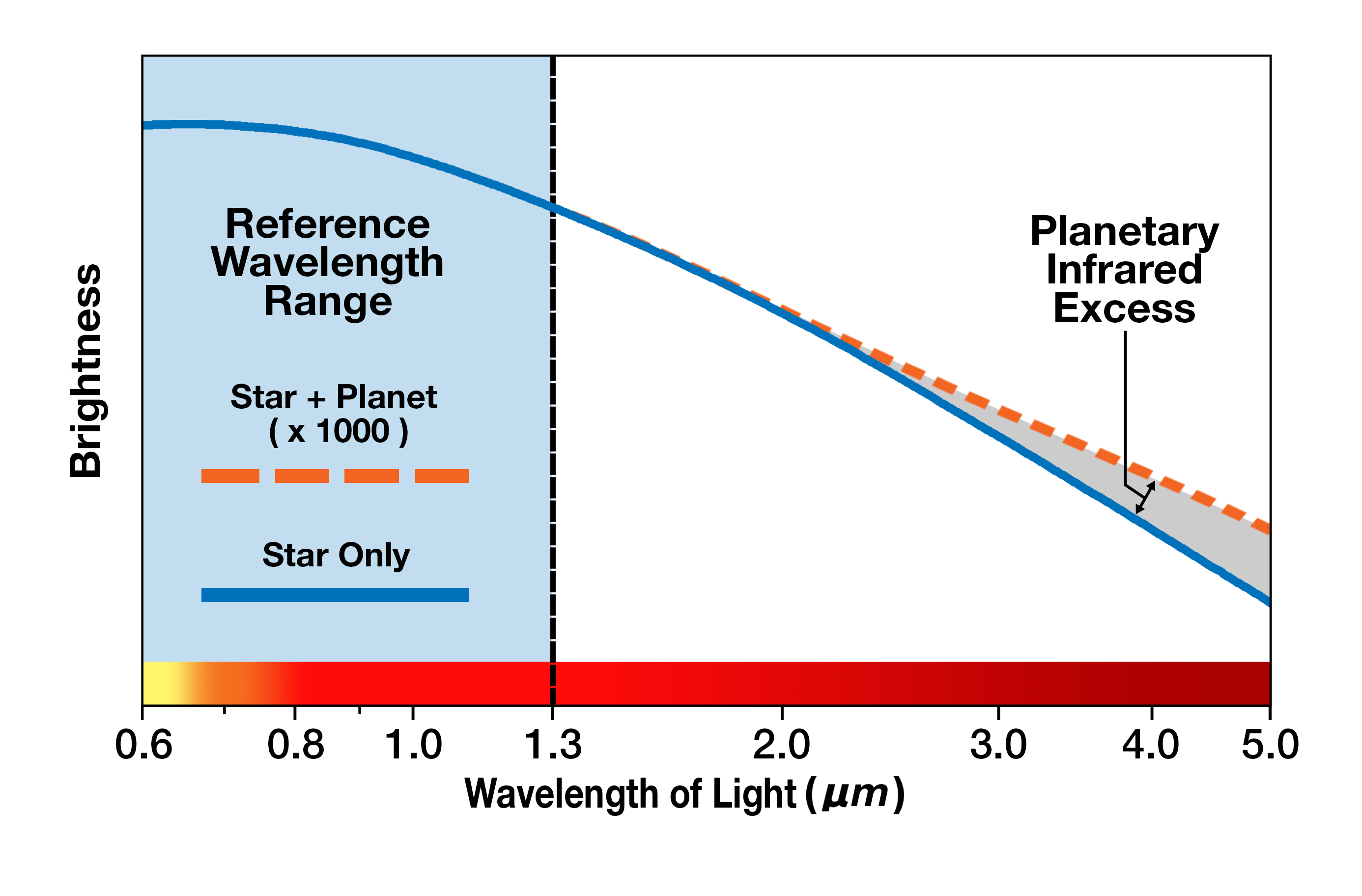How do you find and study the atmosphere of an exoplanet — a planet in another solar system — that, by all current methods, is undetectable?
The question kept gnawing at Kevin Stevenson, an astrophysicist at the Johns Hopkins Applied Physics Laboratory in Laurel, Maryland. And he wasn’t alone. Many exoplanet researchers, trying to study these distant worlds’ atmospheres, have run into the same question because planetary atmospheres can tell a lot about a planet, perhaps most importantly about its habitability and whether its inhabited. But current methods are limited.
To study an exoplanet’s atmosphere requires light, and right now it can be studied only if the planet is large, young and hot enough to produce light that can be directly imaged, or if it passes in front of its star (a transit) or behind its star (a secondary eclipse). Either way allows scientists to distinguish light that’s from the planet and light that’s from its star.

Credit: NASA/ESA/STScI/J. de Wit (MIT)
But large, young and hot planets are usually Jupiter- or Neptune-size gas giants — not ideal when looking for life. And, from Earth’s vantage, a majority of planets never pass in front of or behind their stars. In fact, for planets around red dwarf stars — which make up 75% of stars in our corner of the Milky Way galaxy — only 2% of potentially-habitable exoplanets transit their star, Stevenson said. What if you could see the other 98%?
Stevenson mulled over the problem for months, spit-balling ideas with colleagues at conferences, until slowly, surely, he figured out a way. He dubbed it the planetary infrared excess technique, or PIE, which he wrote about in Astrophysical Journal Letters earlier this year. And it could be a revolutionary fix-up for exoplanet research.
“This method would reveal a huge swath of exoplanets that have previously been inaccessible in terms of atmospheric characterization,” Stevenson said, possibly multiplying the number of exoplanets that can be studied by 50 times.
Rather than depending on a secondary eclipse to determine what light comes from the planet and what comes from the star, PIE relies on two points in wavelength space: one where the planet emits light because of heat, and one where it does not. The method takes advantage of the fact that, at wavelengths of light where the planet is relatively bright, the star tends to be dimmer. And at wavelengths where the star is bright, the planet is dimmer.
Take the Sun and Earth, for example. Although the Sun emits almost every wavelength of light, it most strongly gives off visible light, with a peak around 0.5 micrometers at blue-green light. At longer red and infrared wavelengths, though, the Sun’s emission tapers. But much cooler bodies, like planets, often peak in this region, including Earth, which peaks at 10 micrometers.
Stevenson’s idea is to simultaneously collect wavelengths of light in a sweet spot from 1 to 20 micrometers, where scientists know all planets will emit light. Then, they can model the star’s and the planet’s spectra for comparison.
“We can use the shorter, bluer wavelength range as our reference point, which is where we could fit models to the star,” Stevenson said. “Then, we could extrapolate those models to the longer, redder wavelengths. Any excess infrared light in that range we would attribute to the planet. That’s how, in theory, we could measure the brightness temperature of a planet that’s not transiting.”

Credit: Johns Hopkins APL
PIE will be the primary observational focus of an international team of scientists Stevenson will lead for the next three years, as they further develop the idea through NASA’s new Interdisciplinary Consortia for Astrobiology Research (ICAR), announced last month.
The concept of infrared excess is used elsewhere in astrophysics research, such as distinguishing two stars in a binary star system. When the stars have different temperatures, their peak wavelengths differ, allowing each star to be distinguished by measuring the light it emits.
“This method pushes that idea to an extreme,” Stevenson said.
That extremity creates a few drawbacks. Because planets don’t emit much light, a planet’s peak signal will be very small relative to the star.
As a result, Stevenson plans to look for planets around M-dwarf stars, such as TRAPPIST-1, where seven planets (including three potentially habitable worlds) were discovered in 2017. M-dwarf stars are relatively small, weighing from 7.5% to 50% the mass of the Sun. That makes them thousands of degrees cooler and much dimmer so the light of a planet won’t be washed out.
People have talked about searching for life around M-dwarf stars because of this advantage, Stevenson said. “You just have more signal to work with from the planet.”
The ICAR team Stevenson will lead plans to hone the PIE technique and test it on these M-dwarf stars by leveraging the infrared light-detecting capabilities of future space telescopes, particularly NASA’s James Webb Space Telescope (JWST) and the conceptual Origins Space Telescope (OST).
Using models to simulate JWST’s capability to detect near-infrared wavelengths (0.8-2.5 micrometers), the team can determine the validity of the PIE technique and establish the wavelength range, power and precision necessary for its successful implementation.
Stevenson expects JWST’s narrow reach into the infrared will limit it to studying nontransiting warm Neptunes and hot Jupiters, an ideal starting place to test the idea, he said. From there, they can model OST’s capability to look into the mid-infrared (1.3-3.0 micrometers), which could look at cooler, more Earth-like planets where life might be found.

Related Topics
For Media Inquiries
For all media inquiries, including permission to use images or video in our gallery, please contact:
Michael Buckley
All Media Resources

